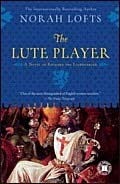First published in 1951 by one of the most skilled historical novelists of her day, The Lute Player revolves around patterns of unrequited love among Berengaria of Navarre, Richard the Lionheart, Richard's sometime minstrel Blondel, and a fictional half-sister of Berengaria named Anna.
Much is known about the historical Richard, who became king of England in 1189 but spent most of his rule away from home, leading the Third Crusade in a vain attempt to wrest Jerusalem from Muslim rule. Little is known of his wife, the Spanish princess Berengaria, and less is known of Blondel, sometimes suspected of being entirely legendary, though musical compositions attributed to him survive.
The real star of this imaginative novel is the fictional Anna. Both Anna and Berengaria are deformed: illegitimate Anna permanently and hideously by the iron corset her mother wore to hide her pregnancy, supremely beautiful Berengaria by her mother's whim to achieve a sort of medieval Botox effect through "the Saracen habit of slitting the eyelids of girl babies in order to give them that doe-eyed, flowerlike look." Though Berengaria spends much of the novel in emotional distress, her tears flow from seemingly placid, untroubled eyes.
The Lute Player is filled with pithy observations about human nature, though some seem to stem more from the post WWII era in which Lofts wrote than from medieval Europe: "There is something pervasive and absorbent about a company of women. They receive, they smother, they infect with their own softness." Despite this, Anna is a sharply witty, fascinating character, as critical of herself as of others, not squishy in the least. Her deformity frees her of the need to be feminine, and it is she who sets the plot in motion, shrewdly planting notions in the minds of more overtly powerful characters, cleverly pulling a thread here and tying off a string there, until she looks back astonished at the events she has set in motion. (1951; new Touchstone edition 2009, 572 pages)




